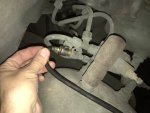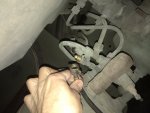- 3,994
- 2,816
- 113
- Location
- Hiawassee, Georgia
I've now moved on to the brakes. Fortunately, I have plenty of DOT 5 fluid in the reservoirs for both the clutch and brakes. I have a good solid brake pedal, which will slow the truck if I stand really hard on the pedal. The problem is lack of air pressure assist. I have zero air pressure at the gauges, both needles. The compressor is running fine. I think I traced the problem to the Fluid Regulating Valve. As the compressor cuts in, you can hear it charging air pressure. However, after about 10 - 15 seconds, a blast of high pressure air exits the bottom port on the Fluid Regulating Valve located on the frame in front of the passenger side rear wheel. This keeps repeating. No air pressure ever builds up in either tank. The part number is: WABCO 975-303-447-0 or BOSCH 0-481-039-202. Someone may have more to add to this. I attached a copy of the removal instructions in TM 5-2420-224-20-2. The diagram on the bottom of the page shows the Fluid Regulating Valve. The unlabeled port on the bottom of the valve is where the high pressure air escapes from every few seconds. High pressure air from the compressor comes into the unit, but doesn't exit out of the line to the tanks. I tried lightly tapping on the regulator with a hammer to no avail. I guess it is also possible that two separate regulators mounted on the inlets of Tank 1 and Tank 2 could have failed instead of the unloader, but I find it unlikely that two different regulators could have failed at the same time, but anything is possible.
Attachments
-
229.9 KB Views: 15
Last edited:




